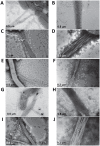Effects of polyamines on Vibrio cholerae virulence properties
- PMID: 23593304
- PMCID: PMC3622680
- DOI: 10.1371/journal.pone.0060765
Effects of polyamines on Vibrio cholerae virulence properties
Abstract
Vibrio cholerae is the causative agent of the severe enteric disease cholera. To cause cholera the bacterium must be able to synthesize both cholera toxin (CT) and toxin-coregulated pilus (TCP) which mediates autoagglutination and is required for colonization of the small intestine. Only a few environmental signals have been shown to regulate V. cholerae virulence gene expression. Polyamines, which are ubiquitous in nature, and have been implicated in regulating virulence gene expression in other bacteria, have not been extensively studied for their effect on V. cholerae virulence properties. The objective of this study was to test the effect of several polyamines that are abundant in the human intestine on V. cholerae virulence properties. All of the polyamines tested inhibited autoagglutination of V. cholerae O1 classical strain in a concentration dependent manner. Putrescine and cadaverine decreased the synthesis of the major pilin subunit, TcpA, spermidine increased its production, and spermine had no effect. Putrescine and spermidine led to a decrease and increase, respectively, on the relative abundance of TCP found on the cell surface. Spermine led to a small reduction in cholera toxin synthesis whereas none of the other polyamines had an effect. The polyamines did not affect pili bundling morphology, but caused a small reduction in CTXφ transduction, indicating that the TCP present on the cell surface may not be fully functional. We hypothesize the inhibition of autoagglutination is likely to be caused by the positively charged amine groups on the polyamines electrostatically disrupting the pili-pili interactions which mediate autoagglutination. Our results implicate that polyamines may have a protective function against colonization of the small intestine by V. cholerae.
Conflict of interest statement
Figures





Similar articles
-
Evolutionary and functional analyses of variants of the toxin-coregulated pilus protein TcpA from toxigenic Vibrio cholerae non-O1/non-O139 serogroup isolates.Microbiology (Reading). 2002 Jun;148(Pt 6):1655-1666. doi: 10.1099/00221287-148-6-1655. Microbiology (Reading). 2002. PMID: 12055286
-
Virulence genes in environmental strains of Vibrio cholerae.Appl Environ Microbiol. 2000 Sep;66(9):4022-8. doi: 10.1128/AEM.66.9.4022-4028.2000. Appl Environ Microbiol. 2000. PMID: 10966424 Free PMC article.
-
The Vibrio cholerae minor pilin TcpB mediates uptake of the cholera toxin phage CTXφ.J Biol Chem. 2019 Oct 25;294(43):15698-15710. doi: 10.1074/jbc.RA119.009980. Epub 2019 Aug 30. J Biol Chem. 2019. PMID: 31471320 Free PMC article.
-
Epidemiology & molecular biology of Vibrio cholerae O139 Bengal.Indian J Med Res. 1996 Jul;104:14-27. Indian J Med Res. 1996. PMID: 8783504 Review.
-
Multiple intraintestinal signals coordinate the regulation of Vibrio cholerae virulence determinants.Pathog Dis. 2018 Feb 1;76(1). doi: 10.1093/femspd/ftx126. Pathog Dis. 2018. PMID: 29315383 Review.
Cited by
-
Arginine Decarboxylase Is Essential for Pneumococcal Stress Responses.Pathogens. 2021 Mar 2;10(3):286. doi: 10.3390/pathogens10030286. Pathogens. 2021. PMID: 33801541 Free PMC article.
-
Stress and polyamine metabolism in fungi.Front Chem. 2014 Jan 10;1:42. doi: 10.3389/fchem.2013.00042. eCollection 2013. Front Chem. 2014. PMID: 24790970 Free PMC article. Review.
-
Amino Acid-Derived Bacterial Metabolites in the Colorectal Luminal Fluid: Effects on Microbial Communication, Metabolism, Physiology, and Growth.Microorganisms. 2023 May 17;11(5):1317. doi: 10.3390/microorganisms11051317. Microorganisms. 2023. PMID: 37317289 Free PMC article. Review.
-
Epidemiologic potentials and correlational analysis of Vibrio species and virulence toxins from water sources in greater Bushenyi districts, Uganda.Sci Rep. 2021 Nov 17;11(1):22429. doi: 10.1038/s41598-021-01375-3. Sci Rep. 2021. PMID: 34789791 Free PMC article.
-
Electrostatic interactions between the CTX phage minor coat protein and the bacterial host receptor TolA drive the pathogenic conversion of Vibrio cholerae.J Biol Chem. 2017 Aug 18;292(33):13584-13598. doi: 10.1074/jbc.M117.786061. Epub 2017 Jun 22. J Biol Chem. 2017. PMID: 28642371 Free PMC article.
References
-
- Sack DA, Sack RB, Nair GB, Siddique AK (2004) Cholera. Lancet 363: 223–233. - PubMed
-
- Ritchie JM, Waldor MK (2009) Vibrio cholerae interactions with the gastrointestinal tract: lessons from animal studies. Curr Top Microbiol Immunol 337: 37–59. - PubMed
-
- Lee SH, Hava DL, Waldor MK, Camilli A (1999) Regulation and temporal expression patterns of Vibrio cholerae virulence genes during infection. Cell 99: 625–634. - PubMed
Publication types
MeSH terms
Substances
Grants and funding
LinkOut - more resources
Full Text Sources
Other Literature Sources

